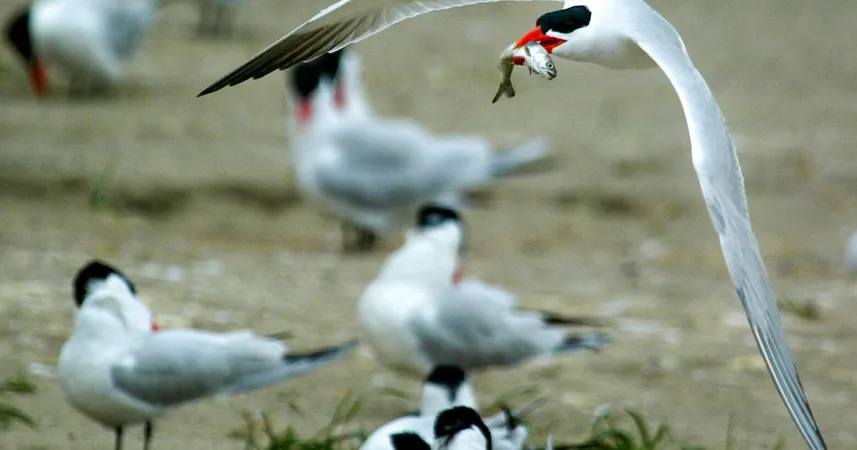
Catastrophic Bird Flu Outbreak Devastates Caspian Terns Near Port Townsend, WA
2024-11-18
Author: Wei
Catastrophic Bird Flu Outbreak Devastates Caspian Terns Near Port Townsend, WA
In a shocking revelation, over half of a Caspian tern colony on Rat Island, located near Port Townsend, has been decimated by an outbreak of bird flu. This alarming incident highlights the severe impact that highly pathogenic avian influenza, known scientifically as H5N1, has on wildlife populations.
Research teams conducted a meticulous count and discovered a staggering 1,101 dead adult terns alongside 520 deceased chicks. The figures reveal that approximately 53% to 56% of the adult terns in this particular colony fell victim to the outbreak. When expanded to the surrounding region, estimates suggest that the bird flu has claimed around 10% to 14% of the population across the Pacific flyway in the previous year.
Furthermore, investigators observed the virus's effects on local harbor seals. Unlike the direct respiratory impacts seen in birds, the disease prompted severe inflammation in the seals' brains, showcasing a disturbing variation in its effects across species.
Katherine Haman, a wildlife veterinarian from the Washington Department of Fish and Wildlife and the study's lead author, stated, “This Caspian tern incident is the first significant marine environment outbreak of avian flu in Washington. It resulted in a notable spike in mortality for a species that was already facing decline within this migratory pathway.”
Caspian terns are migratory birds that return to the Pacific Northwest around late April or May after spending their winters in southern territories. In 2021, there were estimated to be about 10,800 of these birds residing along the Pacific flyway—a vital migratory route between North and South America.
The first reports of sick or dead terns emerged in July 2022, with researchers indicating that adult terns began perishing from the virus on July 3. The outbreak persisted until the end of August, peaking at a devastating rate of 50 casualties per day.
Interestingly, while the tern population faced catastrophic losses, only around 3% of the adult glaucous-winged gulls on the island succumbed to the same disease, though juvenile gulls were significantly more affected, with at least 298 young birds reported dead.
Bird Flu Woes Worsen in Washington
The adverse effects of bird flu are not confined to Rat Island. Recently, cases have flared up across Washington state, including alarming reports from the Woodland Park Zoo in Seattle, where a red-breasted goose has died from a suspected case of bird flu. The zoo has since heightened its protective measures, including draining pools in bird exhibits and relocating free-roaming birds indoors.
Last month, an alarming outbreak impacted a flock of approximately 800,000 poultry at an egg farm in Franklin County, leading to extensive culling and destruction of infected eggs. Disturbingly, this outbreak also spread to humans, with 52 confirmed cases nationwide and 11 in Washington linked to poultry interactions. Health officials confirmed a human case in Oregon as well, raising concerns about the need for increased vigilance in disease monitoring.
Despite low risk levels for the general public, health experts are cautiously observing the potential for the virus to mutate and become transmissible among humans, stressing that the situation remains fluid and necessitates ongoing scrutiny.
Alarmingly Different Effects on Marine Life
The examination of the bird flu's effects on seals revealed concerning outcomes as well. Sixteen dead harbor seals were documented, with testing indicating severe neurological damage and pneumonia. Some nasal swab tests returned negative, but lung and brain tissue showed positive results for the virus. The seals exhibited meningoencephalitis—a severe condition characterized by inflammation of the brain lining—and neuronal necrosis, or death of brain cells.
Kevin Snekvik, a professor at Washington State University, noted the complexity surrounding the diagnosis, emphasizing the necessity for comprehensive testing strategies to uncover the full scope of the virus's impact on different species. He remarked, "This situation underscores the importance of collecting diverse samples to achieve accurate diagnoses."
Investigations have also indicated similar inflammation patterns in other carnivores, such as raccoons and skunks, suggesting a possible link to feeding on infected carcasses. While the exact mechanisms of these manifestations remain unclear, the differing effects across species are a crucial area for further research.
As avian influenza continues to pose a significant threat to wildlife and potentially to human health, it remains imperative for researchers, wildlife officials, and the general public to remain vigilant and informed. The lessons learned from this outbreak may pave the way for better understanding and prevention of future incidents.


 Brasil (PT)
Brasil (PT)
 Canada (EN)
Canada (EN)
 Chile (ES)
Chile (ES)
 España (ES)
España (ES)
 France (FR)
France (FR)
 Hong Kong (EN)
Hong Kong (EN)
 Italia (IT)
Italia (IT)
 日本 (JA)
日本 (JA)
 Magyarország (HU)
Magyarország (HU)
 Norge (NO)
Norge (NO)
 Polska (PL)
Polska (PL)
 Schweiz (DE)
Schweiz (DE)
 Singapore (EN)
Singapore (EN)
 Sverige (SV)
Sverige (SV)
 Suomi (FI)
Suomi (FI)
 Türkiye (TR)
Türkiye (TR)